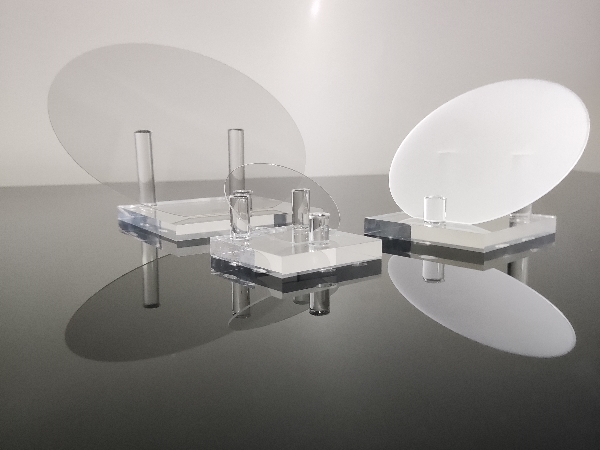
The selection of substrate materials plays a crucial role in the development of high-frequency, high-power RF (radio frequency) devices. Single-crystal sapphire (α-Al₂O₃), with its exceptional physical and chemical properties—such as low dielectric loss, high thermal conductivity, superior hardness, and high-temperature resistance—has demonstrated significant value in the RF field. This article explores the key advantages of sapphire in RF applications, typical device solutions, and future development trends.
Key Technological Advantages of Sapphire
Sapphire has emerged as an ideal material for high-frequency, low-loss RF devices due to the following attributes:
Low dielectric loss: Sapphire exhibits extremely low dielectric loss (tanδ ~10⁻⁴) in the microwave and millimeter-wave frequency ranges, enabling high-Q RF devices.
(1)High thermal conductivity: With a thermal conductivity of approximately 35 W/m·K, sapphire significantly outperforms silicon (Si) and gallium arsenide (GaAs), facilitating efficient heat dissipation in high-power RF devices.
(2)Superior mechanical strength: With a Mohs hardness of 9, second only to diamond, sapphire is well-suited for extreme operating conditions involving high temperature and mechanical stress.
(3)Chemical stability: Sapphire is highly resistant to corrosion and has a melting point of 2050°C, ensuring reliability in harsh environments.
(4)High dielectric constant (ε_r ≈ 9.4): This property enables compact RF circuit designs, contributing to miniaturized and high-performance RF components.
These outstanding properties make sapphire a preferred choice for RF applications that demand high frequency, high efficiency, and long-term stability.
Applications of Sapphire in RF Devices
1. High-Frequency Filters and Resonators
Application Scenarios: 5G/6G communication, satellite communication, radar systems
Technical Solutions:
(1) Film Bulk Acoustic Resonator (FBAR) / Bulk Acoustic Wave (BAW) devices: Sapphire substrates enhance resonator Q-factors, enabling GHz-range high-frequency filters with low insertion loss and high selectivity.
(2) Microwave dielectric resonators: Used in millimeter-wave oscillators and filters, reducing signal attenuation and improving system performance.
2. High-Power RF Amplifiers
Application Scenarios: Base station power amplifiers, radar transmitter modules
Technical Solutions:
(1) GaN-on-Sapphire devices: Sapphire’s high thermal conductivity enables effective heat dissipation, improving the efficiency and reliability of gallium nitride (GaN) power RF devices.
(2) Sapphire-based RF power transistors: The combination of sapphire’s heat dissipation capabilities and GaN’s high-power density reduces thermal resistance and extends device lifespan.
3. Millimeter-Wave and Terahertz Devices
Application Scenarios: 6G communication, terahertz imaging, high-speed wireless transmission
Technical Solutions:
(1) Millimeter-wave antenna arrays: Sapphire’s low dielectric loss minimizes signal attenuation, improving transmission efficiency in high-frequency applications.
(2) Terahertz waveguides: Sapphire substrates support ultra-high-frequency signal transmission and modulation beyond 100 GHz, enabling next-generation communication technologies.
4. RF MEMS Devices
Application Scenarios: Tunable capacitors, RF switches, phase shifters
Technical Solutions:
MEMS structural or packaging layers: Sapphire’s superior mechanical strength and low thermal expansion coefficient enhance MEMS device stability and fatigue resistance.
5. RF Integrated Circuits (RFICs)

Application Scenarios: High-frequency transceiver chips, phased-array radar T/R modules
Technical Solutions:
Sapphire-based RF front-end chips: The integration of GaN high-electron-mobility transistors (HEMTs) on sapphire substrates reduces parasitic capacitance, improving high-frequency performance.
Key Technological Challenges and Solutions
Despite its advantages, sapphire-based RF devices face several technical challenges, including:
High substrate cost:
Solution: Develop partial sapphire substrates (such as sapphire-Si composite substrates) or optimize wafer processing techniques to reduce costs.
1. Challenges in heterogeneous epitaxy:
Solution: Utilize buffer layers (e.g., AlN transition layers) to improve the epitaxial quality of GaN and other materials on sapphire.
2. Difficulties in sapphire processing:
Solution: Employ precision processing techniques such as laser cutting and chemical mechanical polishing (CMP) to achieve high-precision patterning.
3. Future Development Directions
High-frequency and high-power integration: Develop multifunctional sapphire-based RF modules, such as integrated filter-amplifier solutions.
Heterogeneous integration technology: Combine sapphire with silicon, silicon carbide (SiC), and other materials to balance performance and cost.
Expansion into terahertz applications: Explore sapphire’s potential in device design for frequencies beyond 100 GHz, advancing 6G and terahertz technologies.
Advanced packaging technology: Leverage sapphire’s heat dissipation capabilities in combination with 3D packaging solutions to enhance RF system integration and reliability.
Representative Case Studies
Case 1: A well-known manufacturer has developed a GaN-on-Sapphire 5G base station power amplifier, achieving a 15% efficiency improvement and a 20°C reduction in operating temperature.
Case 2: Sapphire-based FBAR filters are utilized in smartphone RF front ends, supporting the 28 GHz band with an insertion loss of less than 1 dB.
Case 3: Sapphire-packaged high-frequency MEMS switches have achieved over 10⁹ switching cycles in satellite communication systems, demonstrating exceptional durability.
Conclusion
Sapphire’s combination of low dielectric loss, high thermal conductivity, and high-frequency compatibility makes it a key enabler in 5G/6G communication, radar, and satellite applications. With advancements in heterogeneous integration and advanced packaging, the performance and cost-effectiveness of sapphire-based RF devices will continue to improve.
For high-frequency, high-reliability applications, sapphire remains an ideal choice, while for cost-sensitive mid-to-low frequency applications, hybrid solutions incorporating sapphire with silicon or SiC offer a viable alternative.
As wireless communication, millimeter-wave, and terahertz technologies continue to evolve, sapphire’s role in next-generation RF systems will expand further, driving the industry toward higher frequency, higher power, and greater integration.
As semiconductor technology advances, Gallium Nitride (GaN) has become a core material in optoelectronics, rad...
With the rapid advancement of third-generation semiconductor technologies, Silicon Carbide (SiC) has emerged a...
As third-generation semiconductor materials such as silicon carbide (SiC) and gallium nitride (GaN) continue t...
